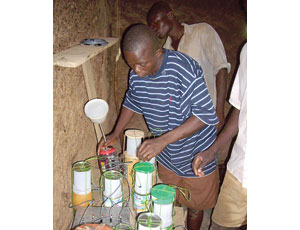The results of recent field trials of rechargeable community solar lighting kits for isolated villages now are being analyzed to help researchers in New York City turn their inventions into a sustainable business plan.

“This is changing people’s lives,” says Toby Cumberbatch, a professor at the Cooper Union for the Advancement of Science and Art’s Center for Sustainable Engineering, Art and Architecture. He started working in 2006 with a team of 26 engineering students to devise an inexpensive community solar lighting system that could be assembled and maintained locally.
The goal of the SociaLite Project is to help impoverished people in rural areas replace dangerous kerosene lanterns with sustainable solar lighting systems. The initial target area is sub-Saharan Africa, but people could benefit from the research across the world in years to come.
The project joins a parade of solar lighting development in Africa, although other projects have focused on supplying off-the-grid individual lighting systems for homes rather than small community systems.
Last summer, working closely with the University of Developmental Studies in Ghana, students and volunteers deployed five kits with 500 lanterns in four rural communities off the electrical grid in northern Ghana and southern Rwanda. “It may not be the cheapest solution or look pretty, but it works,” Cumberbatch says.
Each $2,500 kit contains all the non-local components needed to build an 80-lantern, rechargeable lighting system. Each kit fits into a medium-sized duffle bag.
Kits are built around flexible, 80-watt, triple-layer silicon photovoltaic panels made by Auburn Hills, Mich.-based Uni-Solar.
Travis Coleman, a project manager for the Electric Power Research Institute, an independent energy research organization in Palo Alto, Calif., says that while the flexible panels have a lower energy conversion efficiency compared to glass—10.4% versus up to 22.9% for glass—they are light, they can be rolled, and they are better able to tolerate high temperatures. Those qualities make them a good choice for this use, says Cumberbatch. “The lower efficiency is more than outweighed by the durability and transportation benefits,” he says.
The three-layer collectors have interlinked cells to separately capture light in the red, green and blue wavelengths, increasing power-generation efficiency, especially in marginal, low-light or partially shaded conditions. They are connected to a locally sourced, 75-amp-per-hour car battery for energy storage. Lead-acid batteries are used because of their widespread availability, relative low cost and tolerance of high heat.
A charging station can recharge 13 lanterns at once in four hours. A charged lantern will last 32 hours on the “high” setting, which translates into five to eight evenings of use, the researcher says. Maintaining charges on 80 lanterns for a small community will require social organization. “Scheduling is very important to make the best use of the car battery and sunny days,” says Cumberbatch.
The lantern bases can be made of bamboo, used food cans or gourds. Each base houses 4.5-Ah lead-acid batteries connected to 60-lumen, white-light-emitting diodes. The diodes are shrouded by locally sourced, used plastic juice bottles, which serve as diffusers.
Now that an apparently viable design has been refined, the team hopes to win a contract to supply kits to the Ghanaian government. Their proposition calls for the government to sell kits to local groups who will use pooled funds for 10% deposits, paying off the balance over a year through charging fees.
The team also is seeking funding from foundations and individuals to streamline Socia-Lite systems engineering from the assembly stage to long-term maintenance. Further, it hopes to finalize a self-sustaining business model for the rural poor as well as establish in east and west Africa satellite engineering and distribution centers in which models can be developed and tested for worldwide commercialization.



Post a comment to this article
Report Abusive Comment